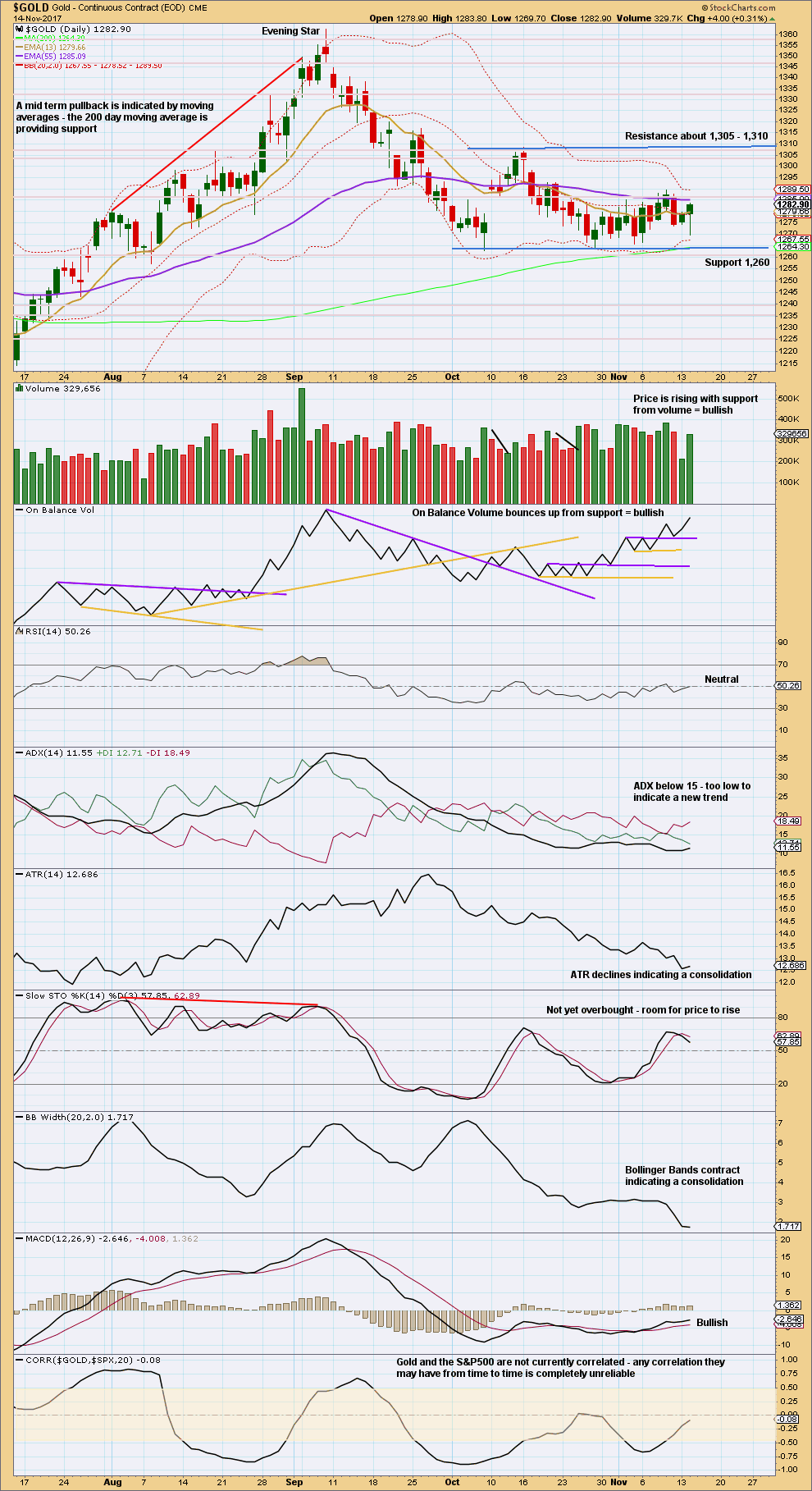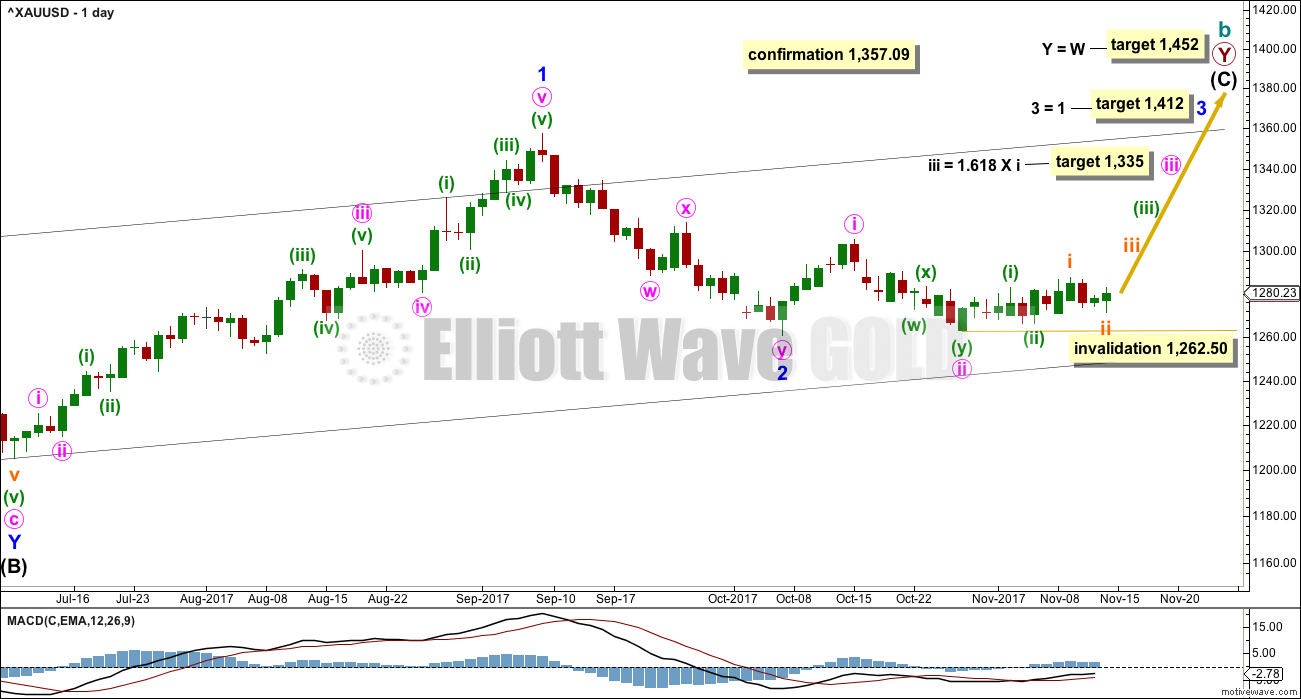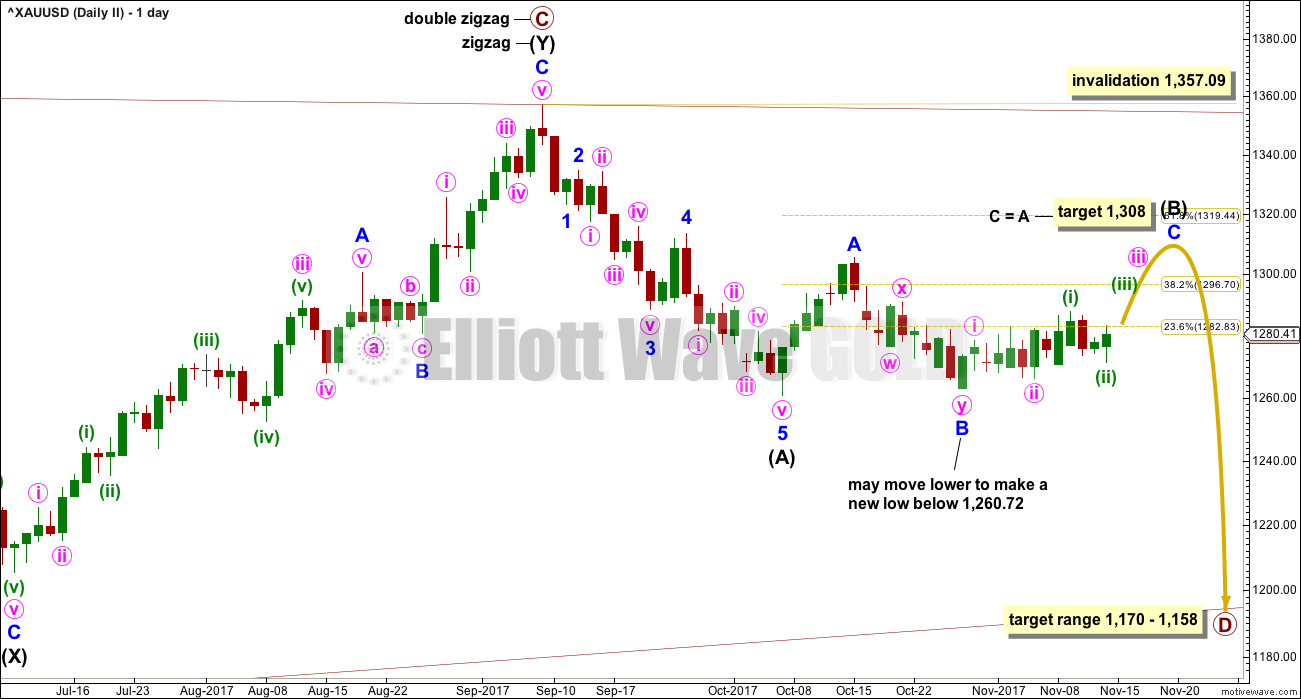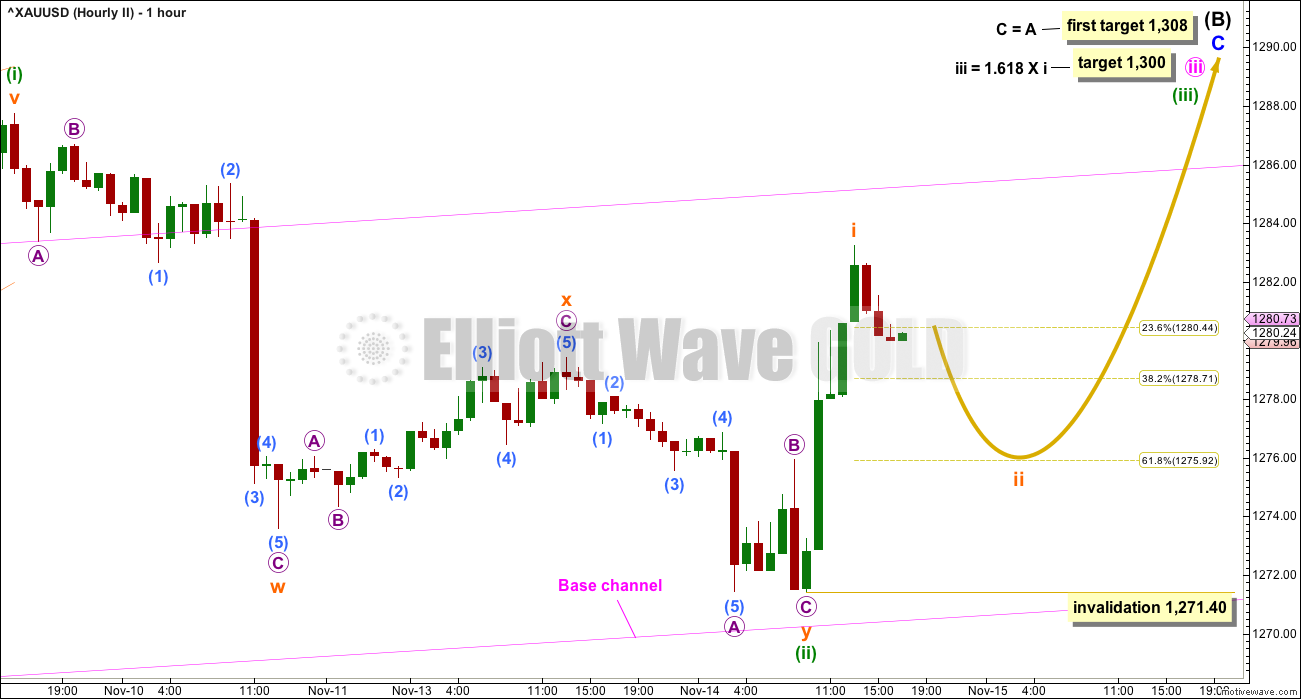Members were advised in last Elliott wave analysis that price may move lower in the very short term to test support at a trend line, which was given on hourly charts. Thereafter, price was expected to turn upwards. This is what has happened. Price moved strongly lower, coming very close to the trend line, before turning upwards.
Members were advised that this should be used as an entry opportunity for long positions. These positions should now be profitable.
Summary: An upwards swing is expected to continue here to end about resistance at 1,305 to 1,310. Along the way up, there may be another small sideways movement to last one to three days.
For the very short term, price may move lower to test the lower edge of the base channel on the hourly charts. If it does do this, then use that as an entry point for a long position.
Only the most experienced of traders should be trading the small swings within a consolidation. If trading the small swings, reduce risk to 1-3% of equity for any one trade and always trade with stops.
New updates to this analysis are in bold.
Last monthly charts for the main wave count are here, another monthly alternate is here, and video is here.
Grand SuperCycle analysis is here.
The wave counts will be labelled first and second. Classic technical analysis will be used to determine which wave count looks to be more likely. In terms of Elliott wave structure the second wave count has a better fit and fewer problems.
FIRST ELLIOTT WAVE COUNT
WEEKLY CHART
Both wave counts expect that Gold completed a large five down from the all time high in November 2011 to the low of December 2015, which is seen on the left hand side of both weekly charts.
If this analysis is correct, then the five down may not be the completion of the correction. Corrective waves do not subdivide as fives; they subdivide as threes. The five down is seen as cycle wave a within a Super Cycle wave (a).
Both wave counts then expect cycle wave b began in December 2015.
There are more than 23 possible corrective structures that B waves may take. It is important to always have multiple wave counts when B waves are expected.
It looks unlikely that cycle wave b may have been over at the high labelled primary wave W. Primary wave W lasted less than one year at only 31 weeks. Cycle waves should last one to several years and B waves tend to be more time consuming than other Elliott waves, so this movement would be too brief for cycle wave b.
This first wave count expects that cycle wave b may be an incomplete double zigzag.
While this first wave count is entirely possible, there are three problems now which reduce its probability.
1. Cycle wave b is a double zigzag, but primary wave X within the double is deep and time consuming. While this is possible, it is much more common for X waves within double zigzags to be brief and shallow.
2. Intermediate wave (B) within the zigzag of primary wave Y is a double flat correction. These are extremely rare, even rarer than running flats. The rarity of this structure must further reduce the probability of this wave count.
3. Although intermediate wave (C) should be continuing so that primary wave Y ends substantially above the end of primary wave W, the duration and depth of minor wave 2 within it now looks to be too large at the weekly time frame.
Within intermediate wave (C), no second wave correction may move beyond the start of its first wave below 1,205.41. However, prior to invalidation, this wave count may be discarded if price breaks below the lower edge of the black Elliott channel. If this wave count is correct, then intermediate wave (C) should not break below the Elliott channel which contains the zigzag of primary wave Y upwards.
DAILY CHART
The analysis will focus on the structure of intermediate wave (C). To see details of all the bull movement for this year see daily charts here.
Intermediate wave (C) must be a five wave structure, either an impulse or an ending diagonal. It is unfolding as the more common impulse.
Minor wave 1 was a long extension. The target for minor wave 3 expects that too to be a long extension. If this is the case, then minor wave 5 may be shorter (only two actionary waves in an impulse may be extended).
The target for minute wave iii fits with higher targets and expects it to exhibit the most common Fibonacci ratio to minute wave i.
If price makes a new high above 1,357.09, then the second wave count below would be discarded and more confidence may be had in this first wave count.
This first wave count expects now that recent movement should be the start of a third wave. Price is not behaving like it is within a third wave at minor degree, it is too slow and weak. This first wave count is further reduced in probability.
HOURLY CHART
Minuette wave (iii) may have begun with a leading contracting diagonal for subminuette wave i. Leading diagonals in first wave positions are commonly followed by very deep second waves. Here, subminuette wave ii is a 0.76 correction of subminuette wave i, meeting the definition of very deep. The structure is now complete as a double zigzag.
Subminuette wave iii may only subdivide as an impulse. This first wave count now expects that there should be a series of four overlapping first and second waves. At this stage, within minor wave 3, price should not be moving this slowly.
SECOND ELLIOTT WAVE COUNT
WEEKLY CHART
Both wave counts are identical to the low labelled cycle wave a. Thereafter, they look at different possible structures for cycle wave b.
This wave count looks at cycle wave b to be most likely a regular contracting triangle.
The B-D trend line should have a reasonable slope for this triangle to have the right look, because the A-C trend line does not have a strong slope. A barrier triangle has a B-D trend line that is essentially flat; if that happened here, then the triangle trend lines would not converge with a normal look and that looks unlikely.
Primary wave D should be a single zigzag. Only one triangle sub-wave may be a more complicated multiple, and here primary wave C has completed as a double zigzag. This is the most common triangle sub-wave to subdivide as a multiple.
Primary wave D of a contracting triangle may not move beyond the end of primary wave B below 1,123.08.
At its completion, primary wave D should be an obvious three wave structure at the weekly chart level. Within primary wave D, intermediate wave (B) is incomplete. At its completion, it too should be an obvious three wave structure at the weekly chart level.
DAILY CHART
At this stage intermediate wave (B) looks incomplete.
A common length for triangle sub-waves is from 0.8 to 0.85 the length of the prior wave. Primary wave D would reach this range from 1,170 to 1,158.
Intermediate wave (A) lasted twenty days, just one short of a Fibonacci twenty-one. Intermediate wave (B) may be about the same duration, so that this wave count has good proportions, or it may be longer because B waves tend to be more complicated and time consuming.
So far intermediate wave (B) has lasted twenty-seven sessions, it is incomplete and needs several more sessions now to complete. The next Fibonacci ratio in the sequence is thirty four.
At this stage, intermediate wave (B) will be labelled as a flat correction. But it may morph into a double combination or triangle and complete as another structure; if this happens, then the target at 1,308 may be too high. Intermediate wave (B) may be a complicated sideways movement, which may be very choppy and characterised by declining ATR and poor trading opportunities.
HOURLY CHART
Intermediate wave (B) may become clearer as its structure continues to unfold, so this hourly chart may be relabelled. The complexity of B waves means that flexibility in analysis is essential, and that there is more than the normal level of risk for traders.
For this second wave count, if intermediate wave (B) is unfolding as a flat correction, then minor wave C upwards must subdivide as a five wave structure. It may be either an impulse or an ending diagonal. An impulse is more common, and that will be how it will be labelled until it proves otherwise. If it looks like a rising wedge is unfolding, then an ending diagonal will be published also.
If minor wave C is an impulse, then it would have begun now with two overlapping first and second waves. The slow upwards movement over the last nearly three weeks here is entirely acceptable.
If minor wave C is an impulse, then at this stage it should begin to show some increase in upwards momentum.
Subminuette wave ii may not move beyond the start of subminuette wave i below 1,271.40.
TECHNICAL ANALYSIS
WEEKLY CHART

Click chart to enlarge. Chart courtesy of StockCharts.com.
Price has again made a higher high and a higher low for the week and this upwards movement has support from volume.
The long upper wick on this weekly candlestick is bearish.
On Balance Volume gave a weak bearish signal last week with a break below a yellow support line. But then On Balance Volume returned back above that line this week, so the line is adjusted to better show where On Balance Volume is finding support. This may now be read as a weak bullish signal.
DAILY CHART

Click chart to enlarge. Chart courtesy of StockCharts.com.
Price is very clearly consolidating. Expect swings from support to resistance and back again. Use Stochastics in conjunction with support and resistance to signal when each swing ends. Be aware that trading a consolidating market is much more risky than trading a trending market, and reduce risk accordingly. Only experienced traders should consider trading the swings within a consolidation. Reduce risk to 1-3% of equity. Always trade with stops. Here, move stops to a little below support and above resistance to allow for overshoots; give the market room to move.
With Stochastics very close to oversold and price at support, an upwards swing may now be beginning. Look for resistance about 1,305 – 1,310. This also supports the second Elliott wave count.
For the short term, today’s candlestick with a long lower wick is bullish. With volume and On Balance Volume bullish, it looks most likely that tomorrow will see another green daily candlestick.
GDX DAILY CHART

Click chart to enlarge. Chart courtesy of StockCharts.com.
An upwards swing may be expected to continue to resistance about 23.95.
Price does not move in straight lines within consolidations, making them poor trading opportunities. If trading this upwards swing, then reduce risk to only 1-3% of equity to acknowledge higher risk.
Published @ 07:55 p.m. EST.







Lara, what do you make of the USD? The daily channel broke down before completing the pattern. The move up since Sept now looks like a DZZ. I’m thinking price could now move below the Sept low. Thoughts?
It looks like my target won’t be met. It looks like it’s had a trend change… at intermediate degree possibly.
Either my wave count of intermediate (A) was wrong in my labelling of the end of it, and it is a complete impulse, or as you say it’s a double ZZ.
And so yes, that means it could now make a new low.
Thank you Dreamer and thank you Lara,
Just for learning purposes, how should the second zigzag be drawn? I tried the best I could and am not able to. I am not able to draw the iv and v waves of the minute and the minuette degrees. Or maybe just ignore the minuette waves? That way minute by itself fits just so, so.
This is only educational as the channel has been broken and also because of the invalidation point, it can no longer be taken as a new impulse up, so if you do not have the time no worries.
Thanks.
My choice would be the EUR/USD
Okay. One vote for EURUSD 🙂
One for Natural Gas.
And over at EWSM they’re voting too…. a few votes there for RUT….
Question for everybody today:
I need to do something free for the public for SEO for this website today. I’m thinking a full analysis on something I don’t normally do.
Any requests for analysis of a particular market? Anyone for a currency? An index? Another commodity?
If it’s a market I don’t have a current or updated EW count on then I could also video the process, that style seems to be popular. To show you all the thinking process I go through to develop an EW count and then how I use classic TA to decide it’s probability.
Natural gas is popular on Stocktwits
New idea. Daily chart.
Intermediate (B) as a triangle.
Minor B really only fits as a double zigzag. Which means if this wave count is correct minor C must be a single zigzag. Only one triangle sub-wave may be a multiple.
Hourly chart.
And so minor C must subdivide 5-3-5. This fits so very well indeed! So far that is…
Minute a is a leading contracting diagonal. Minute b a zigzag.
Now the current movement for minute c looks like an ending diagonal.
So now the last wave up looks like a three doesn’t it, well this wave count needs to see it as a three.
Within ending diagonals all the sub-waves must subdivide as zigzags.
Now for minuette (iv) to complete it should take a bit of time so that the diagonal trend lines don’t converge too quickly. Minuette (iv) cannot be longer than minuette (ii) if this is a contracting diagonal, and it should be because minuette (iii) is a little shorter than minuette (i).
Updated second hourly chart:
Another deep correction!
It’s now starting more and more to look like a B wave is underway, which supports the second wave count quite strongly. And that it may not be a flat, it may be a triangle.
I’ll be now charting and publishing that possibility so we can get a visual image of how price may move through it.
Goodness. B waves really are the worst.
Interesting: Gold price having tip toed up to almost the upper band / 50dma faced rejection, should not really break below 1277 with 1271-69 seen as holding to possibly make another attempt (spurt) at breaking above 1287-89. Range bound going nowhere. With a flattening yield curve and drop in stock pricing may just be the tonic Gold price is looking for an uptick lol…. Tough trading this; unpredictable, horrible! 🙂 Oh well….
I can’t remember it being this difficult. Positions can’t be held for more than a few hours, holding for any kind of run is being punished. My interpretation overall is this is bearish, however, that too can change in a day. Trade small, keep losses small and stops tight until further notice. It’s a drag
Well, its almost senseless trying to trade this lol… low ADX reading on the daily and weekly appears to indicate a consolidation is in progress and a market that will be difficult to trade. At CMP 1277/78 oversold stochastic seems to suggest a price rise. Remains to be seen if 1288-89 can be taken out with some conviction or Gold price fails at 1280-81. GL! Tomorrow is another day lol
🙁 I agree completely Syed. It’s what I’ve been pointing out for a week now, that price is consolidating and ATR is declining. Now it’s way too low for profitable trades.
What I do think would be a good idea in this environment would be to either open a hedge or get positioned long. Stops really need to let the market have some room to move. That’s if you would want to hold on for a few days to a week and get a strong upwards move.
OR
Very short term trades. Using the green base channel would work very nicely. That’s showing where price is finding support and resistance.
OR
Be very patient and wait on the sidelines for a breakout. That may not come for some weeks though 🙁
This kind of market is why everyone should learn to trade credit spreads. There are times when simply nothing else can be done safely and/or profitably…